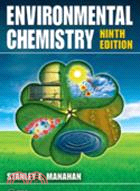ENVIRONMENTAL CHEMISTRY 9E
商品資訊
商品簡介
Features
•Provides an overview of environmental and sustainability science and defines environmental and green chemistry
•Introduces the special characteristics of water and the environmental chemistry of water
•Discusses specific aspects of aquatic chemistry, aquatic biochemistry, and water sustainability and treatment
•Presents an examination of the geosphere that includes soil and agricultural chemistry, transgenic crops, and conservation tillage
•Covers the nature and environmental chemistry of hazardous wastes and industrial ecology for waste minimization, utilization, and treatment
•Includes discussion of the toxicological chemistry of various classes of chemical substances
Summary
The field of environmental chemistry has evolved significantly since the publication of the first edition of Environmental Chemistry. Throughout the book’s long life, it has chronicled emerging issues such as organochloride pesticides, detergent phosphates, stratospheric ozone depletion, the banning of chlorofluorocarbons, and greenhouse warming. During this time the first Nobel Prize for environmental chemistry was awarded. Written by environmental chemist Stanley Manahan, each edition has reflected the field’s shift of emphasis from pollution and its effects to its current emphasis on sustainability.
What makes this book so enduring? Completely revised, this ninth edition retains the organizational structure that has made past editions so popular while updating coverage of principles, tools, and techniques to provide fundamental understanding of environmental chemistry and its applications. Rather than immediately discussing specific environmental problems, Manahan systematically develops the concept of environmental chemistry so that when specific pollutions problems are discussed, the background necessary to understand the problem has already been developed.
New in the Ninth Edition:
•Revised discussion of sustainability and environmental science
•Updates information on chemical fate and transport, cycles of matter
•Examination of the connection between environmental chemistry and green chemistry
•Coverage of transgenic crops
•The role of energy in sustainability
•Potential use of toxic substances in terrorist attacks
Manahan emphasizes the importance of the anthrosphere — that part of the environment made and operated by humans and their technologies. Acknowledging technology will be used to support humankind on the planet, it is important that the anthrosphere be designed and operated in a manner that is compatible with sustainability and that it interacts constructively with the other environmental spheres. With clear explanations, real-world examples, and updated questions and answers, the book emphases the concepts essential to the practice of environmental science, technology, and chemistry while introducing the newest innovations in the field.
目次
The Environment and Sustainability Science
From the Sun to Fossil Fuels and Back Again
The Science of Sustainability
Chemistry and the Environment
Water, Air, Earth, Life, and Technology
Ecology, Ecotoxicology, and the Biosphere
Energy and Cycles of Energy
Human Impact and Pollution
Chemical Fate and Transport
Chemical Fate and Transport in the Atmosphere, Hydrosphere, and Geosphere
Environmental Mischief and Terrorism
Environmental Forensics
Literature Cited
Supplementary References
Questions and Problems
Chemistry and the Anthrosphere: Environmental Chemistry and Green Chemistry
Environmental Chemistry
Matter and Cycles of Matter
Anthrosphere and Environmental Chemistry
Technology and the Anthrosphere
Infrastructure
Components of the Anthrosphere That Infl uence the Environment
Effects of the Anthrosphere on Earth
Integration of the Anthrosphere into the Total Environment
Green Chemistry
Literature Cited
Supplementary References
Questions and Problems
Fundamentals of Aquatic Chemistry
Importance of Water
Water from Molecules to Oceans
Characteristics of Bodies of Water
Aquatic Life
Introduction to Aquatic Chemistry
Gases in Water
Water Acidity and Carbon Dioxide in Water
Alkalinity
Calcium and other Metals in Water
Complexation and Chelation
Bonding and Structure of Metal Complexes
Calculations of Species Concentrations
Complexation by Deprotonated Ligands
Complexation by Protonated Ligands
Solubilization of Lead Ion from Solids by NTA
Polyphosphates and Phosphonates in Water
Complexation by Humic Substances
Complexation and Redox Processes
Literature Cited
Supplementary References
Questions and Problems
Oxidation–Reduction in Aquatic Chemistry
The Signifi cance of Oxidation–Reduction
Electron and Redox Reactions
Electron Activity and pE
The Nernst Equation
Reaction Tendency: Whole Reaction from Half-Reactions
The Nernst Equation and Chemical Equilibrium
The Relationship of pE to Free Energy
Reactions in Terms of One Electron-Mole
The Limits of pE in Water
pE Values in Natural Water Systems
pE–pH Diagrams
Humic Substances as Natural Reductants
Photochemical Processes in Oxidation–Reduction
Corrosion
Literature Cited
Supplementary References
Questions and Problems
Phase Interactions in Aquatic Chemistry
Chemical Interactions Involving Solids, Gases, and Water
Importance and Formation of Sediments
Solubilities
Colloidal Particles in Water
Colloidal Properties of Clays
Aggregation of Particles
Surface Sorption by Solids
Solute Exchange with Bottom Sediments
Interstitial Water
Phase Interactions in Chemical Fate and Transport
Literature Cited
Supplementary References
Questions and Problems
Aquatic Microbial Biochemistry
Aquatic Biochemical Processes
Algae
Fungi
Protozoa
Bacteria
The Prokaryotic Bacterial Cell
Kinetics of Bacterial Growth
Bacterial Metabolism
Microbial Transformations of Carbon
Biodegradation of Organic Matter
Microbial Transformations of Nitrogen
Microbial Transformations of Phosphorus and Sulfur
Microbial Transformations of Halogens and Organohalides
Microbial Transformations of Metals and Metalloids
Literature Cited
Supplementary References
Questions and Problems
Water Pollution
Nature and Types of Water Pollutants
Elemental Pollutants
Heavy Metals
Metalloids
Organically Bound Metals and Metalloids
Inorganic Species
Algal Nutrients and Eutrophication
Acidity, Alkalinity, and Salinity
Oxygen, Oxidants, and Reductants
Organic Pollutants
Pesticides in Water
Polychlorinated Biphenyls
Emerging Water Pollutants, Pharmaceuticals, and Household Wastes
Radionuclides in the Aquatic Environment
Literature Cited
Supplementary References
Questions and Problems
Water Treatment
Water Treatment and Water Use
Municipal Water Treatment
Treatment of Water for Industrial Use
Sewage Treatment
Industrial Wastewater Treatment
Removal of Solids
Removal of Calcium and Other Metals
Removal of Dissolved Organics
Removal of Dissolved Inorganics
Sludge
Water Disinfection
Natural Water Purifi cation Processes
Green Water
Water Conservation
Protecting Water Supplies from Attack
Literature Cited
Supplementary References
Questions and Problems
The Atmosphere and Atmospheric Chemistry
The Atmosphere and Atmospheric Chemistry
Importance of the Atmosphere
Physical Characteristics of the Atmosphere
Energy Transfer in the Atmosphere
Atmospheric Mass Transfer, Meteorology, and Weather
Inversions and Air Pollution
Global Climate and Microclimate
Chemical and Photochemical Reactions in the Atmosphere
Acid–Base Reactions in the Atmosphere
Reactions of Atmospheric Oxygen
Reactions of Atmospheric Nitrogen
Atmospheric Water
Influence of the Anthrosphere
Chemical Fate and Transport in the Atmosphere
Literature Cited
Supplementary References
Questions and Problems
Particles in the Atmosphere
Particles in the Atmosphere
Physical Behavior of Particles in the Atmosphere
Physical Processes for Particle Formation
Chemical Processes for Particle Formation
The Composition of Inorganic Particles
Toxic Metals in the Atmosphere
Radioactive Particles
The Composition of Organic Particles
Effects of Particles
Water as Particulate Matter
Atmospheric Chemical Reactions Involving Particles
Control of Particulate Emissions
Literature Cited
Supplementary References
Questions and Problems
Gaseous Inorganic Air Pollutants
Inorganic Pollutant Gases
Production and Control of Carbon Monoxide
Fate of Atmospheric CO
Sulfur Dioxide Sources and the Sulfur Cycle
Sulfur Dioxide Reactions in the Atmosphere
Nitrogen Oxides in the Atmosphere
Acid Rain
Ammonia in the Atmosphere
Fluorine, Chlorine, and their Gaseous Compounds
Reduced Sulfur Gases
Literature Cited
Supplementary References
Questions And Problems
Organic Air Pollutants
Organic Compounds in the Atmosphere
Biogenic Organic Compounds
Pollutant Hydrocarbons
Carbonyl Compounds: Aldehydes and Ketones
Miscellaneous Oxygen-Containing Compounds
Organonitrogen Compounds
Organohalide Compounds
Organosulfur Compounds
Organic Particulate Matter
Hazardous Air Pollutants Organic Compounds
Literature Cited
Supplementary References
Questions and Problems
Photochemical Smog
Introduction
Smog-Forming Emissions
Smog-Forming Reactions of Organic Compounds in the Atmosphere
Overview of Smog Formation
Mechanisms of Smog Formation
Reactivity of Hydrocarbons
Inorganic Products from Smog
Effects of Smog
Literature Cited
Supplementary References
Questions and Problems
The Endangered Global Atmosphere
Climate Change and Anthropogenic Effects
Global Warming
Green Science and Technology to Alleviate Global Warming
Acid Rain
Stratospheric Ozone Destruction
Atmospheric Brown Clouds
Atmospheric Damage by Photochemical Smog
Nuclear Winter
What Is to Be Done?
Literature Cited
Supplementary References
Questions and Problems
The Geosphere and Geochemistry
Introduction
The Nature of Solids in the Geosphere
Physical Form of the Geosphere
Internal Processes
Sediments
Clays
Geochemistry
Groundwater in the Geosphere
Environmental Aspects of the Geosphere
Earthquakes
Volcanoes
Surface Earth Movement
Stream and River Phenomena
Phenomena at the Land/Ocean Interface
Phenomena at the Land/Atmosphere Interface
Effects of Ice
Effects of Human Activities
Air Pollution and the Geosphere
Water Pollution and the Geosphere
Waste Disposal and the Geosphere
Literature Cited
Supplementary References
Questions and Problems
Soil and Agricultural Environmental Chemistry
Soil and Agriculture
Nature and Composition of Soil
Acid−Base and Ion-Exchange Reactions in Soils
Macronutrients in Soil
Nitrogen, Phosphorus, and Potassium in Soil
Fertilizers
Pollutants from Livestock Production
Pesticides and their Residues in Soil
Wastes and Pollutants in Soil
Soil Loss and Degradation
Saving the Land
Genetic Engineering and Agriculture
Green Chemistry and Sustainable Agriculture
Agriculture and Health
Protecting the Food Supply from Attack
Literature Cited
Supplementary References
Questions and Problems
Green Chemistry and Industrial Ecology
Changing the Bad Old Ways
Green Chemistry
Reduction of Risk: Hazard and Exposure
Waste Prevention and Green Chemistry
Green Chemistry and Synthetic Chemistry
Feedstocks
Reagents
Stoichiometric and Catalytic Reagents
Media and Solvents
Enhancing Reactions
Industrial Ecology
The Five Major Components of an Industrial Ecosystem
Industrial Metabolism
Materials Flow and Recycling in an Industrial Ecosystem
The Kalundborg Industrial Ecosystem
Consideration of Environmental Impacts in Industrial Ecology
Life Cycles: Expanding and Closing the Materials Loop
Life-Cycle Assessment
Consumable, Recyclable, and Service (Durable) Products
Design for Environment
Inherent Safety
Industrial Ecology and Ecological Engineering
Literature Cited
Supplementary References
Questions and Problems
Resources and Sustainable Materials
Where to Get the Stuff We Need?
Minerals in the Geosphere
Extraction and Mining
Metals
Metal Resources and Industrial Ecology
Nonmetal Mineral Resources
Phosphates
Sulfur
Wood: A Major Renewable Resource
Extending Resources through the Practice of Industrial Ecology
Literature Cited
Supplementary References
Questions and Problems
Sustainable Energy: The Key to Everything
Energy Problem
Nature of Energy
Sources of Energy Used in the Anthrosphere
Energy Devices and Conversions
Green Technology and Energy Conversion Efficiency
Energy Conservation and Renewable Energy Sources
Petroleum and Natural Gas
Coal
Carbon Sequestration for Fossil Fuel Utilization
Industrial Ecology for Energy and Chemicals
Nuclear Energy
Geothermal Energy
The Sun: An Ideal, Renewable Energy Source
Energy from Moving Air and Moving Water
Biomass Energy
Hydrogen as a Means to Store and Utilize Energy
Combined Power Cycles
A System of Industrial Ecology for Methane Production
Literature Cited
Supplementary References
Questions and Problems
Nature, Sources, and Environmental Chemistry of Hazardous Wastes
Introduction
Classifi cation of Hazardous Substances and Wastes
Sources of Wastes
Flammable and Combustible Substances
Reactive Substances
Corrosive Substances
Toxic Substances
Physical Forms and Segregation of Wastes
Environmental Chemistry of Hazardous Wastes
Physical and Chemical Properties of Hazardous Wastes
Transport, Effects, and Fates of Hazardous Wastes
Hazardous Wastes and the Anthrosphere
Hazardous Wastes in the Geosphere
Hazardous Wastes in the Hydrosphere
Hazardous Wastes in the Atmosphere
Hazardous Wastes in the Biosphere
Hazardous Substances in Terrorism
Literature Cited
Supplementary References
Questions and Problems
Industrial Ecology for Waste Minimization, Utilization, and Treatment
Introduction
Waste Reduction and Minimization
Recycling
Physical Methods of Waste Treatment
Chemical Treatment: An Overview
Green Waste Treatment by Photolyis and Sonolysis
Thermal Treatment Methods
Biodegradation of Wastes
Phytoremediation
Land Treatment and Composting
Preparation of Wastes for Disposal
Ultimate Disposal of Wastes
Leachate and Gas Emissions
In Situ Treatment
Literature Cited
Supplementary References
Questions and Problems
Environmental Biochemistry
Biochemistry
Biochemistry and the Cell
Proteins
Carbohydrates
Lipids
Enzymes
Nucleic Acids
Recombinant DNA and Genetic Engineering
Metabolic Processes
Metabolism of Xenobiotic Compounds
Literature Cited
Supplementary References
Questions and Problems
Toxicological Chemistry
Introduction to Toxicology and Toxicological Chemistry
Dose–Response Relationships
Relative Toxicities
Reversibility and Sensitivity
Xenobiotic and Endogenous Substances
Toxicological Chemistry
Kinetic Phase and Dynamic Phase
Teratogenesis, Mutagenesis, Carcinogenesis, and Effects On the Immune and Reproductive Systems
Health Hazards
Literature Cited
Supplementary References
Questions and Problems
Toxicological Chemistry of Chemical Substances
Introduction
Toxic Elements and Elemental Forms
Toxic Inorganic Compounds
Toxicology of Organic Compounds
Toxic Natural Products
Literature Cited
Supplementary References
Questions and Problems
Chemical Analysis of Water and Wastewater
General Aspects of Environmental Chemical Analysis
Classical Methods
Spectrophotometric Methods
Electrochemical Methods of Analysis
Chromatography
Mass Spectrometry
Analysis of Water Samples
Automated Water Analyses
Speciation
Emerging Contaminants in Water Analysis
Chiral Contaminants
Literature Cited
Supplementary References
Questions and Problems
Analysis of Wastes and Solids
Introduction
Sample Digestion for Elemental Analysis
Analyte Isolation for Organics Analysis
Sample Cleanup
Sample Preparation for VOCs
Bioassay and Immunoassay Screening of Wastes
Determination of Chelating Agents
Toxicity Characteristic Leaching Procedure
Literature Cited
Supplementary References
Questions and Problems
Analysis of the Atmosphere and Air Pollutants
Atmospheric Monitoring
Sampling
Methods of Analysis
Determination of Sulfur Dioxide
Nitrogen Oxides
Analysis of Oxidants
Analysis of Carbon Monoxide
Determination of Hydrocarbons and Organics
Analysis of Particulate Matter
Direct Spectrophotometric Analysis of Gaseous Air Pollutants
Literature Cited
Supplementary References
Questions and Problems
Analysis of Biological Materials and Xenobiotics
Introduction
Indicators of Exposure to Xenobiotics
Determination of Metals
Determination of Nonmetals and Inorganic Compounds
Determination of Parent Organic Compounds
Measurement of Phase I And Phase II Reaction Products
Determination of Adducts
The Promise of Immunological Methods
Literature Cited
Supplementary References
Questions and Problems
Index
主題書展
更多書展本週66折
您曾經瀏覽過的商品
購物須知
為了保護您的權益,「三民網路書店」提供會員七日商品鑑賞期(收到商品為起始日)。
若要辦理退貨,請在商品鑑賞期內寄回,且商品必須是全新狀態與完整包裝(商品、附件、發票、隨貨贈品等)否則恕不接受退貨。

























